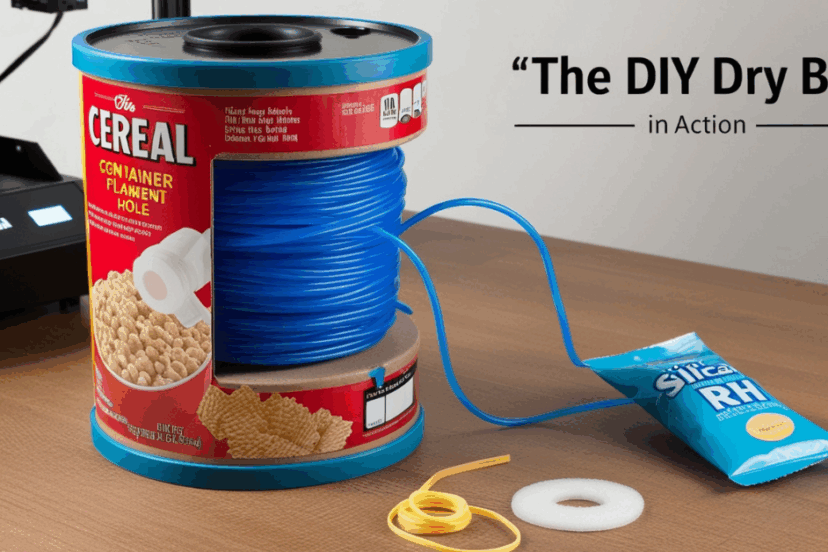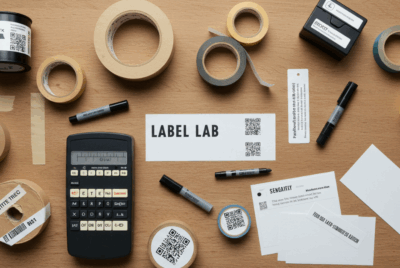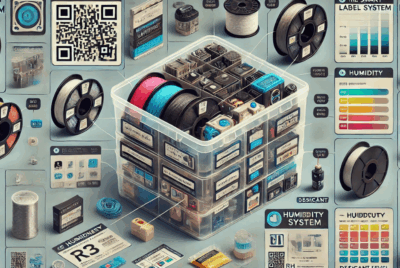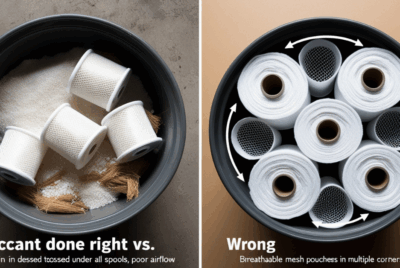Can You Use Regular Food Storage Containers to Store Filament?
1. Introduction: The Budget Filament Storage Hack
You’ve probably seen it online or in a maker forum:
“I just store my filament in food containers with some silica gel, and it works fine!”
Sounds too simple, right?
Well… it’s not wrong. You can store filament in regular food containers—if you do it right.
Let’s unpack what works, what doesn’t, and how to make the most of this cost-effective storage method.
2. Why People Use Food Storage Containers for Filament
- They’re cheap
- They’re easy to find (Target, Walmart, Amazon)
- Most are airtight or snap-sealed
- They’re stackable and space-efficient
- No fancy equipment or electronics needed
Especially if you’re starting out, food bins can be a great first step toward proper filament care.
3. What Makes a Container “Filament-Safe”?
For filament storage, the container must be:
✅ Airtight (not just “lidded”)
✅ Large enough for 1–4 spools
✅ Made of plastic or metal (not breathable fabric)
✅ Compatible with desiccant or humidity cards
✅ Easy to open/close without compromising the seal
Bonus if it has a gasket seal and locking sides.
4. Types of Food Storage Containers You Can Use
Here are some options that have worked well for makers:
| Container Type | Good for Filament? | Notes |
|---|---|---|
| Cereal containers | ✅ Yes | For 1 spool with feed hole |
| Airtight pantry bins | ✅ Yes | Multiple spools |
| Pet food bins | ✅ Yes | Often come with seal + wheels |
| Large meal prep tubs | ⚠️ Maybe | Only if gasketed |
| Glass containers | ❌ No | Too small, fragile |
| Fabric-lined or vented | ❌ No | Not moisture-proof |
5. What to Look for in a Good Container
Before tossing your spools in a bin, check for:
- Rubber gasket in the lid
- Snap-on locks or screw-top
- Wide enough base for filament reels
- Rigid material that won’t warp
- Clear walls (optional) for visibility
Example: IRIS airtight containers, Oxo Pop pantry bins, or Buddeez Pet Food Dispensers.
6. How to Seal Food Containers for Maximum Moisture Protection
Even a good bin needs a little help:
- Add silica gel packs to absorb moisture
- Toss in a humidity card so you can monitor RH
- Limit how often you open the bin
- Don’t overfill—spools need a bit of air space
- For extra security: wrap the lid edge with weather-seal tape
7. Best Affordable Airtight Food Storage Containers
Here are some real-world tested options:
| Brand | Model | Capacity | Notes |
|---|---|---|---|
| IRIS USA | 12 Qt or 19 Qt Weathertight | 3–5 spools | Durable, stackable |
| Oxo | Good Grips Pop Containers | 1–2 spools | Sleek, strong seal |
| Komax Biokips | XL Storage Box | 4+ spools | Locking clamps, airtight |
| Buddeez | 8-gal Pet Food Bin | 6–8 spools | Rolling lid, deep interior |
All are under \$30 and widely available.
8. DIY Tips to Upgrade Food Containers for Filament
Want to level up a basic bin?
- Drill a filament feed hole + rubber grommet for dry-box-style printing
- Add hook-and-loop straps to hold the spool in place
- Insert foam spacers to reduce internal movement
- Paint or wrap clear bins to block UV light
- Use double lids or lid covers to slow air entry
A few small tweaks = pro-level storage.
9. What NOT to Use for Filament Storage
Avoid:
❌ Soft plastic containers with poor seals
❌ Lids without clamps or rubber gaskets
❌ Open-topped pantry bins
❌ Mesh or vented containers (used for fruits or tools)
❌ Anything with cracks, gaps, or warped lids
These won’t protect against ambient humidity—no matter how dry your room is.
10. How to Add Desiccant to Food Containers
- Use color-changing silica gel (orange/green or blue/pink)
- Place in mesh pouch or small cup
- Avoid direct contact with filament (can cause residue)
- For bigger bins, use 100g+ per 2–3 spools
- Recharge regularly by baking
Pro tip: Toss in a humidity card to monitor changes without opening.
11. Should You Add a Hygrometer Inside?
Yes—especially for larger containers.
Use:
- Mini digital hygrometers like ThermoPro TP49
- Bluetooth sensors (Govee, Inkbird) for remote readings
- Or cheap humidity cards for basic monitoring
Anything above 30–40% RH? Time to dry or refresh the silica.
12. Are Food Storage Bins Better Than Vacuum Bags?
| Feature | Food Storage Bin | Vacuum Bag |
|---|---|---|
| Cost | Low | Low |
| Stackability | ✅ Yes | ❌ No |
| Airtight? | ✅ If sealed | ✅ If maintained |
| Access ease | ✅ Easy | ❌ Needs unsealing |
| Long-term? | ⚠️ Good | ✅ Excellent |
Best practice:
Use bins for active spools and vacuum bags for long-term storage.
13. Storing Multiple Spools in Large Food Bins
Large bins (like 10–20 gallon ones) can hold up to 10 spools, if:
- You keep them upright or stacked safely
- Add enough desiccant for the volume
- Use dividers or foam to avoid pressure points
- Store in a cool, dark, dry place
Don’t forget to label spools or lids with dry dates and filament type!
14. Real-World Maker Setups Using Food Containers
Makers worldwide share setups like:
- Cereal containers with a single spool and feed hole
- Pantry bins labeled and lined up by color
- Rolling pet food bins with built-in dry storage
- Repurposed breadboxes or Tupperware with humidity cards inside
It’s not about spending more—it’s about thinking smarter.
15. Final Thoughts: Good Storage Doesn’t Have to Be Expensive
You don’t need a high-end dry box to store filament properly.
With a little planning, food storage containers can:
✅ Keep filament dry
✅ Save space
✅ Cost you less than \$30
✅ Fit into any DIY setup
Just add silica, a label, and a humidity check, and you’ve got yourself a maker-approved filament vault.
❓FAQs
- Can I print directly from a food storage container?
Yes—drill a filament feed hole, insert a grommet, and you’re set! - Do food containers keep filament dry long-term?
Only if they’re airtight and include fresh desiccant. Otherwise, use them for short to mid-term storage. - How many spools can I fit in a standard pantry container?
Most can hold 2–4 spools, depending on width and whether you stand them up or lay them flat. - What’s better—food container or a filament dry box?
Dry boxes offer active drying and real-time monitoring. Food containers are more affordable for passive storage. - Can I store filament in plastic grocery bins?
Not recommended unless you modify them to be airtight and add moisture control.




